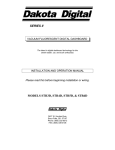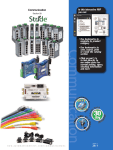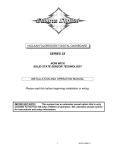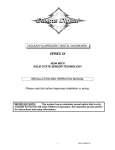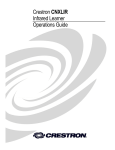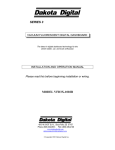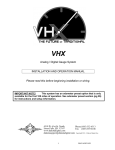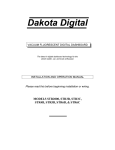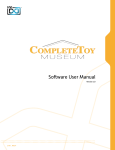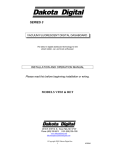Download Dakota Digital STR4D Service manual
Transcript
SERIES II VACUUM FLUORESCENT DIGITAL DASHBOARD The latest in digital dashboard technology for the street rodder, car, and truck enthusiast. INSTALLATION AND OPERATION MANUAL Please read this before beginning installation or wiring. MODEL STR6D-GM 92-94 Chevrolet Full Size Pickup kit 3421 W. Hovland Ave. Sioux Falls, SD 57107 Phone: (605) 332-6513 FAX: (605) 339-4106 Thank you for purchasing the Vacuum Fluorescent Digital Dashboard from DAKOTA DIGITAL, the leader in custom automotive electronics. Representing the latest electronics dashboard technology for the street rodder, car, and truck enthusiast alike, the digital instrumentation uses state of the art vacuum fluorescent display technology to give the driver up to date and accurate information on the operation of his or her vehicle. As used in several production automobiles, vacuum fluorescent displays give superior performance and visual appeal over LCD or LED display systems. Emitting a blue/green light that can be filtered to a wide variety of colors, the VFD system boasts excellent daytime visibility and while under computer control, automatically dims for nighttime driving. Using microprocessor technology, the digital dashboard gives the driver additional features and benefits not typically found on any other brand or type of instrumentation. Digital accuracy and solid state reliability will give you, the driver, quality service for miles down the road. DISPLAY FEATURES Your DAKOTA DIGITAL instrumentation panel has many features, some of which you will not be able to see until the instrumentation is completely wired and installed. The odometer is the bottom display of the speedometer area. This is the same display that will function as the resettable trip-odometer. The digit furthest to the right of the odometer will become your gear shift indicator if you purchased the optional gear shift sending unit. Every DAKOTA DIGITAL instrumentation panel is equipped with this indicator. If you did not originally order a gear shift sending unit, and would like to have a gear shift indicator, you may order the sending unit at anytime and when properly installed, the gear shift indicator will operate. WARNING The vacuum fluorescent displays are made of glass and should be handled with care. Use extreme care around the glass evacuation tubes (small tubes at the bottom of each display) as bumping them may cause breakage and render the display useless. INSTALLING THE DISPLAY SYSTEM The first step in installing your new digital gauge kit will be to remove the instrumentation cluster from your vehicle. The front plastic bezel must be removed first. Once this has been taken off, you can begin removing the instrument cluster. There are four screws which hold the instrument cluster in, two on each side. It may be necessary to move the heater vent duct or radio to get to the screws. Once the instrument cluster has been removed, take the four screws out which hold the black hood onto the cluster. Remove the hood. Turn the gauge housing over so you can see the back side. Unplug the four wire, black connector found in the center of the back side. Remove the six large gray light bulbs. Do not remove any of the small gray bulbs, or the large black bulb by the gear shift position indicator. The bulbs are taken out by rotating it counterclockwise 1/8 turn and then pulling it. Turn the housing back over so the front is facing you. The gauges consist of a single panel which can be pulled out of the housing. Remove this since they will no longer be used. The pin connections for the gauge panel holds it in very tightly so some force will be required. Start by working gently along the outside edges. Once it is out, you will see a small green circuit panel in the lower right side of the housing. Remove this also. You are now ready to install the digital gauge panel. The screws sticking out of the back side will insert into the housing to make connection with the vehicle senders and wiring. The colored wires and flat gray cable coming out of the back side of the display panel will be routed out the hole in the center of the housing. Carefully place the display panel into the housing and press down evenly on the display panel until it hits the bottom and stops. Place a washer and nut onto a screw sticking out of the back side of the housing. This will help ensure that the display panel does not vibrate loose. You are now ready to install the new lens onto the hood. Remove the two screws on the top side of the instrument cluster hood which hold the curved plastic lens on. Set the clear plastic lens aside. Place a bead of clear or black silicone RTV around the bottom inside edge of the hood from the front side. The lens will be placed onto the front, inside lip of the hood and the RTV will hold it into place. The RTV will need several hours to cure before the hood can be placed back onto the instrument housing. Once the RTV has cured, place the hood and curved plastic lens back onto the housing and secure it using the six screws that were originally in it. The wires coming out of the back of the housing will connect to the control box terminal strip. See the following section for wire color and location. After connecting the wires, the gauge housing is ready to go back into the dash. Reverse the disassembly procedure to put your dash back together. The control box can be mounted up under the dash or against the fire wall. The control box can be secured using screws, Velcro, or nylon cable ties. The system uses the original vehicle senders so you are now ready to drive away. CONTROL BOX Once the display panel is in place, mount the control box within the connecting cable's distance (approximately 3 feet) and secure to the underside of the dashboard. This case does not have to be mounted to metal, but by doing so you will provide a better ground to the control box. When connecting the display cable to the unit, be very sure to pay attention to the "up" side of the connector. Align the connector in the socket and press firmly into the control box. The connector locks will secure the connector. Wiring the control box into the vehicle. +12V Connect the +12V terminal to the RED wire from the display panel. Never connect this to a battery charger alone. It needs to have a 12 volt battery connected to it. Battery chargers have an unregulated voltage output that will cause the system to not operate properly. GROUND This is the main ground for the display system. Connect the BLACK wire from the display panel to this terminal. Proper vehicle grounding is extremely important for the gauges to read and operate correctly. The engine block should have heavy ground cables to the battery, frame, and body. Failure to properly ground the engine block or the control box can cause incorrect or erratic operation. DIMMING The gauges are designed to dim down when the headlights are turned on. This is to reduce the display intensity at night so the gauges do not cause eye strain or reduced night vision. In order for the automatic dimming feature fo the display system to operate properly, the “DIM” terminal must be connected to the park light circuit. The WHITE wire supplied with the system can be used to connect the DIM terminal to the park light circuit on your headlight switch. This will be a brown wire on position “A” of the headlight switch connector. The display system will dim whenever the “DIM” terminal has 12 volts applied to it. The night brightness level is adjustable two different ways. The default method is to have the system to dim to a preset level when the lights are turned on. This brightness is adjusted by turning the shaft protruding from right side of the control box, next to the display system connector. Turning the shaft clockwise will decrease the brightness. The shaft will rotate ¾ turn from stop to stop. Do not attempt turn it past the stops. See DIM ADJ for a description of the second method. DIM ADJ The second method allows you to have a dash mounted control to vary the brightness while the headlights are on. This requires a 10k potentiometer or Dakota Digital’s DIM-1 kit. A stock headlight rheostat will not work. The dash mount dimmer has two wires, one connects to the DIM ADJ terminal and the other connects to ground. To allow the dash mount dimmer to have full control, the shaft on the side of the control box must be turned fully counter-clockwise. The dash mount dimmer will only vary the display brightness when the DIMMING terminal has power. SPEED The BROWN wire from the display panel connects to the SPEED terminal. This system can accept 4000 ppm – 128000 ppm speed signals. The control box has been pre-calibrated to the 4000ppm signal from the display panel. The speedometer is fully adjustable and calibration is discussed in a later section. TACH Connect the tach terminal to the YELLOW wire coming from the display panel. DO NOT USE SOLID CORE SPARK PLUG WIRES WITH THIS DASHBOARD SYSTEM. Solid core ignition wires cause a large amount of electromagnetic and radio frequency interference which can disrupt the system operation. The tachometer is compatible with 4, 6, 8, and 10 cylinder gasoline engines. There are DIP programming switches inside the control box that set the number of cylinders, tach bar graph full scale range, and tach display type. These settings are discussed later in the section on internal adjustments. WATER This system is designed to use an original equipment General Motors water temperature gauge sender. Other senders will cause incorrect readings. The sender mounts on the engine block so that the end of the sensor is in the engine coolant flow. Connect the GREEN wire from the display panel to the control box terminal marked WATER. If the water display shows “---“ this indicates that the control box is sensing a short to ground or out-of-range error from the sender or sender wire. If the water display shows “EEE” this indicates that the control box is sensing an open circuit or out-of-range error from the sender or sender wire. If either indication remains on the display, inspect the sender wire for damage, check the routing of the sender wire, check the sending unit grounding, and check that the correct sending unit is connected. OIL This system is designed to use an original equipment General Motors 80 psi oil pressure sender. Other senders will cause incorrect readings. Connect the GRAY wire from the display panel to the control box terminal marked OIL. If the oil display shows “EE” this indicates that the control box is sensing an open circuit or out-ofrange error from the sender. If either indication remains on the display, inspect the sender wire for damage, check the routing of the sender wire, check the sending unit grounding, and check that the correct sending unit is connected. FUEL Connect the PURPLE wire from the display panel to the control box terminal marked FUEL. The fuel sender type is selected using the DIP programming switches located inside the control box. The settings are discussed later in the section on internal adjustments. If the fuel display shows “—“ this indicates that the control box is sensing a short to ground or out-of-range error from the sender or sender wire. If the fuel display shows “EE” this indicates that the control box is sensing an open circuit or out-of-range error from the sender. If either indication remains on the display, inspect the sender wire for damage, check the routing of the sender wire, check the sending unit grounding, and check that the DIP programming switches are set correctly for the sending unit that is connected. TRIP The TRIP terminal is used for the trip odometer function, for setting the oil warning set point (see WRN), and for speedometer calibration (see SPEEDOMETER CALIBRATION). The TRIP input is activated by a ground connection. The push button switch supplied (or any normally open switch) is wired by connecting one terminal to TRIP and the other terminal to a ground. When the trip button is pressed, the odometer display will switch from full odometer mileage to the trip mileage or from the trip mileage to the full odometer mileage. When the trip mileage is shown a lower case “t” will be displayed to the left of the trip meter reading. “t 000.0” RESET The RESET terminal is used for the trip odometer function, for setting the water warning set point (see WRN), and for the speedometer calibration (see SPEEDOMETER CALIBRATION). The RESET input is activated by a ground connection. The push button switch supplied (or any normally open switch) is wired by connecting one terminal to RESET and the other terminal to a ground. When the reset button is pressed and held for a few seconds, the trip miles will be reset to zero. This will not affect the full odometer mileage. CHECK The check engine terminal is used with fuel injection ECM’s to display engine problems and trouble codes. The CHECK input is activated by a ground signal from the ECM. Whenever the check input is grounded the system will display a lower case “c” to the right of the speedometer. When the ECM is placed into diagnostic mode trouble codes can be read by counting the flashes. Consult a service manual for the fuel injection system that you have for further information on trouble codes. With some ECM’s a 12 volt light bulb may need to be connected in addition to our CHECK input in order to provide proper current loading. In this case both the bulb and our display system indicator would both come on when the check engine wire was set. BRAKE The BRAKE terminal can be used as a brake system warning indicator. The BRAKE input is activated by a ground signal from the brake pressure switch on the master cylinder or from the parking brake set switch. Connect a wire from this terminal to the pressure switch on the master cylinder or consult a vehicle service manual to determine color and location of an existing wire. Whenever the BRAKE input is grounded the system will display a “b” to the left of the speedometer. HI BEAM The HI BEAM terminal is activated by a 12 volt signal from the headlight high beam wire. When the terminal has 12 volts, a dot will light up to the lower right of the speedometer display. An existing wire from the vehicle for the high beam indicator can be used or a new wire can be connected from the high beam side of the hi beam/low beam switch. LEFT The LEFT terminal is activated by a 12 volt signal from the turn signal switch. When this terminal has 12 volts, a dash will light up to the left of the speedometer display. An existing wire from the vehicle for the left turn indicator can be used or a new wire can be connected from the turn signal switch. RIGHT The RIGHT terminal is activated by a 12 volt signal from the turn signal switch. When this terminal has 12 volts, a dash will light up to the right of the speedometer display. An existing wire from the vehicle for the right turn indicator can be used or a new wire can be connected from the turn signal switch. WRN The WRN terminal is a dual function input and output. The output is ground-activated when the preset rpm limit is exceeded. This output can turn on a 4 Watt or smaller 12 volt bulb or can activate a relay to turn on a larger bulb. To wire a warning light to this output, connect one wire from the bulb to 12 volt accessory power and connect the other wire to the WRN terminal. The input is used to set the water, oil, and rpm warning set points. See the Gauge Warning section for a description of how to set these. MPH/KPH The MPH/KPH terminal is activated by a 12 volt signal from a push button or toggle switch(not supplied). When the display system is in English mode (MPH & °F) by placing DIP programming switch #7 off, applying 12 volts to this terminal will convert the speed reading from MPH to KPH. The odometer will continue to accumulate miles correctly, but will display dashes. The bar speed display, if present, will not be affected. When the display system is in Metric mode (KPH & °C) by placing DIP programming switch #7 on, applying 12 volts to this terminal will convert the speed reading from KPH to MPH. The odometer will continue to accumulate kilometers correctly, but will display dashes. The bar speed display, if present, will not be affected. This input is provided to allow a convenient method of switching from MPH to KPH or from KPH to MPH while crossing borders or driving in areas with different speed markings. GEAR SHIFT INDICATOR INPUTS The PARK, REVERSE, NTRL, OVRDRV, DRIVE, 2nd,and 1st terminals are used for the gear shift indicator. The inputs are activated be a 12 volt signal from a gear shift sending unit. The indicator is built into every system but it will not light up unless a Dakota Digital GSS-1000 or compatible gear shift sending unit is connected to tell it what gear the transmission is in. The gear shift sending unit is not included with the system and must be purchased separately. When the gear shift sending unit is connected, a letter will light up to the right of the odometer to indicate what gear the transmission is in. Below is a chart showing the display indicators for each of the gears and a wiring diagram using Dakota Digital’s GSS-1000 adjustable gear shift sending unit. If you have a different gear shift sending unit, consult the wiring instructions supplied by the manufacturer. Safety Backup Power Dim Park Reverse Neutral Overdrv Drive Second First HI Signal Ground GSS-1000 DECODER +12V to Chassis Ground to sensor BLACK wire to sensor GREEN wire to sensor RED wire to control box FIRST terminal to control box SECOND terminal to control box DRIVE terminal to control box OVERDRIVE terminal to control box NEUTRAL terminal do not connect to control box REVERSE terminal to control box PARK terminal (optional) (optional) Insert cable with red stripe to right side. Optional display power connector used only on STR4D/5D systems. Setting up the control box SPEEDOMETER CALIBRATION The speedometer calibration is done using the TRIP and RESET switches. There are two different ways to calibrate the speedometer. The first method control box uses an auto-cal mode where you drive one mile (1 km for metric) and the system automatically adjusts the speedometer calibration. The second method allows you to adjust the speedometer up or down as you drive. To enter the auto-calibration mode, begin with the key off. Press and hold both the trip and reset switches at the same time while the vehicle is started. The speed will display “CAL”. Once the switches are released the control box will begin measuring. As you drive the odometer will display the number of pulses received from the sensor. If the reading stays at zero as you drive, then check the vehicle speed sensor and speed sensor wiring. Once you have driven exactly one mile (or km) press and hold both of the switches again. The system will calculate and store the new speed calibration. Once the switches are released the system will restart and go back to normal operation. While the system is in the auto-cal mode the voltage, fuel, oil, and water gauges will remain blank will not change until the speed calibration is completed. To enter the speedometer adjust mode, press and hold both the trip and reset switches at the same time while the system is on and operating. The switches will need to be held for about 4-6 seconds. The odometer will display “AdJUSt” and the other gauges will function normally. Release the switches. Pressing and holding the TRIP switch will increase the speedometer reading. Pressing and holding the RESET switch will decrease the speedometer reading. Pressing and holding both the TRIP and RESET switches at the same time will store the current speed calibration and exit the speed adjust mode. While the system is in speed adjust mode the odometer will continue to accumulate normally, even though it is not displayed. FUEL DIP SWITCH SETTINGS The control box can read 5 different types of fuel senders. The DIP programming switches are located inside the control box, so the cover must be carefully removed to get access to the switches. Make sure the key is turned off before opening up the control box so that there is no power to the system. The switches labeled 1, 2, and 3 are used to select the different sender types. Once the switches have been set, replace the cover before turning the system on. The sender types are listed below, along with their corresponding empty and full resistance readings. If you do not know what type of sender you have, use an ohmmeter to measure the fuel sender resistance when it is full and empty. Ford fuel senders are not supported with this system. Sender type Empty R Full R Switch #1 Switch #2 Switch #3 GM 0-30 ohm GM 0-90 ohm 0 ohms 0 ohms 30 ohms 90 ohms ON OFF ON ON OFF OFF FORD VDO 73 ohms 10 ohms 10 ohms 180 ohms OFF OFF OFF SW/SUN 240 ohms 33 ohms OFF ON ON SW/SUN is the default setting when systems are shipped unless it was requested to be set differently. TACHOMETER DIP SWITCH SETTINGS The control box will work with 4, 6, 8, and 10 cylinder ignition systems. The DIP programming switches are located inside the control box, so the cover must be carefully removed to get access to the switches. Make sure the key is turned off before opening up the control box so that there is no power to the system. The switches numbers 5 and 6 select the number of engine cylinders. The settings are as follows: Engine cylinders Switch #5 Switch #6 Bar tach Switch #4 4 6 8 10 ON OFF ON OFF ON ON OFF OFF 6000 rpm 8000 rpm OFF ON The default setting when systems are shipped from the factory is 8 cylinder. In addition, the tachometer bar graph can be set to read 6000 rpm at full scale(switch #4 OFF) or 8000 rpm at full scale(switch #4 ON). This option would have been specified when the order was originally placed and the switch should be set to match the display system lens engraving. Systems with both a digital and bar graph tachometer are always set for 8000 full scale(switch #4 ON). Because some systems have a digital speedometer with a bar graph tachometer directly above it(88 Chevy pickup) and some systems a have separate digital speedometer and digital tachometer, each having their own bar graph readout(94 Chevy pickup), switch #8 selects which style display system is being used. For 5-gauge systems with a bar graph tachometer directly above the speedometer, turn switch #8 OFF. For 6-gauge systems with a bar graph speedometer directly above the digital speedometer, turn switch #8 ON. This is set correctly at the factory before shipping to match the display system that it is paired with. METRIC SELECTION DIP SWITCH SETTINGS Switch #7 selects whether the temperature will be displayed in °F or °C and also sets the speedometer for MPH or KPH. For MPH/°F turn switch #7 OFF. For KPH/°C turn switch #7 ON. Changing switch #7 does not change the speedometer calibration. Speedometer calibration is discussed in another section. This switch will be set from the factory to match the display system lens engraving. If this is changed, a new lens should be purchased so that the labeling matches the gauge readings. GAUGE WARNING FEATURE The gauges have the built in feature to alert you when they are outside their normal operation range. The fuel display will flash whenever the fuel level is below 10% to indicate low fuel. The voltage gauge will flash whenever the system voltage is below 11.0 volts and the engine is running. The water gauge will flash whenever the temperature is higher than the water warning set point. The oil gauge will flash whenever the oil pressure is below the oil warning set point and the engine is running. The WRN output will be activated whenever the rpm warning set point is exceeded. A single. lit bar on the right half of the rpm bar display shows the current rpm warning set point. The rpm warning set point can either be used as a shift indication or as a red line indication. The rpm warning output is triggered off the bar tach and is updated every 1/8 second. The water, oil, and rpm warning set points are user adjustable. They are preset at the factory to 250 for water, 10 for oil, 4560 for 6000 bar tachs, and 6080 for 8000 bar tachs. The warning set points are adjusted using the TRIP, RESET, and WRN terminals. To enter the warning adjust mode, ground the WRN terminal while the system is turned on. The speedometer will display “AdJ”. Release the ground from the WRN terminal. The current warning set points will be displayed. The RESET, TRIP, and WRN inputs adjust the water, oil, and rpm warning set points respectively. Once the set points have been changed, if an input is not activated for 8 seconds the values will be saved and the system will begin operating normally. To change the water warning set point, press and hold the RESET button until the desired value is shown. The range is from 194 – 254°F in 2° increments (90 – 123°C). To change the oil warning set point, press and hold the TRIP button until the desired value is shown. The range is from 2 – 30 psi in 2 psi increments. To change the rpm warning set point, ground the WRN terminal until the desired value is displayed. For 0-6000 bar tachs, the range is from 2160-5760 rpm in 120 rpm increments. For 0-8000 bar tachs, the range is from 2880-7680 rpm in 160 rpm increments. GAUGE SPECIFICATIONS Gauge WATER OIL FUEL VOLT SPEED ODOMETER TRIP METER TACH bar TACH digital Minimum reading Maximum reading 0°F (0°C) 299°F (148°C) 0 psi 80 psi 0% (empty) 99% (full) 8.0 volts 18.0 volts 0 mph (kph) 255 mph (kph) 00000.0 miles (km) 99999.9 miles (km) 000.0 miles (km) 999.9 miles (km) 400 rpm 6000 rpm or 8000 rpm 400 rpm 9990 rpm Power requirements: 11 – 15 volts dc (Battery charges cannot be used for powering or testing this system.) Resolution 1 - 2° 1 psi 1 - 3% 0.1 volt ±0.1 1 0.1 0.1 120 or 160 10 TROUBLESHOOTING GUIDE This is a list of some problems and their solutions which may be encountered when installing your instrumentation system. If you cannot determine what the problem is or how to solve it, please call our technical assistance line (605) 332-6513. * A note on vehicle grounding. * The most common cause of problems with electric gauges is poor ground connections. The engine block has the highest ground currents of any point in the vehicle. The ignition system, electric gauge senders, starter, alternator, etc. all use the engine block for a ground point. Since the alternator is grounded directly to the engine block all ground currents in the entire vehicle must pass through the engine block while the engine is running. A weak or loose connection can cause all kinds of random problems that may difficult to track down. The engine block should have heavy ground straps to both the chassis and the body. The main negative cable from the battery should be connected directly to the engine block. Symptom Possible Problem Solution ----------------------------------------------------------------------------------------------------------------------------------System does not light up. Control box may not be getting Check if the control box has power. 12 volts connected to it. Do not use a battery charger to power the system. Check the fuse inside the control box. If it is blown, replace with a 2 amp fuse. The display system may not be Insert the connector on the getting power. display system wiring harness into the slot on the side of the control box. Be sure the pins line up properly. Check the display system wiring harness for broken or cut wires. The control box may have Return the control box to Dakota an internal problem Digital with a description of the problem and a phone number. A display shows dashes. The sending unit for that display is not connected to the control box. Check the wire from sending unit to the control box for breaks. Make sure that the sending unit is wired to the correct terminal. Make sure the sending unit is grounded properly. One display does not light up. If the circle in the upper right corner of the display is white, the display is cracked or broken Return the display panel to Dakota Digital for repair. Include a phone number and address. The tachometer will not show a reading. The control box is not connected to the engine properly Make sure the control box is connected to your particular system properly. Symptom Possible Problem Solution ----------------------------------------------------------------------------------------------------------------------------------The tachometer reading The tachometer signal wire is Check the connections at both is incorrect. loose or broken. ends of the wire. The control box is not set up for Refer to the Internal Adjustments the proper number of cylinders section of the installation manual or the proper tach range. to set the control box properly. The speedometer will not show a reading. The speed sending unit is not connected to the control box properly. The speed sending unit is not connected to the transmission properly. The sending unit wire is picking up noise from nearby wires. The vehicle speed buffer is not working correctly. The fuel display reads backwards, incorrectly, or does not change. The control box may be set for the wrong type of fuel sender. The fuel sender may not be connected to the control box properly. The fuel sender may not be operating properly. The fuel sender may have a non-standard resistance range. The oil or water display reading is incorrect. The engine block may not be grounded to the chassis frame or body properly. The sending unit wire is picking up noise from nearby wires. The sending unit is not compatible with the control box The sending unit has failed. Check that both speed sending unit wires are connected to the control box properly. Check that sender is mounted properly. Check that transmission has the appropriate internal parts. Isolate the sending unit wire from motor and ignition wires. Check the stock VSS buffer according to the GM service manual. Refer to the Internal Adjustments section of the installation manual to ensure that the settings match your fuel sender. Check the connections at both ends of the fuel sender wire. Make sure the fuel sender is grounded properly. Check the fuel sending unit with a mechanical gauge or an electrical multi-meter. If the proper resistance range setting is not available with the control box settings, replace the fuel sender with a different style. Use heavy ground cables from the battery to the engine block. Make sure both ends of the cable have clean metal-to-metal connections. Use a braided ground strap to ground the engine block to the chassis. Use a large braided ground strap to ground the engine block to the body or fire wall. Isolate the sending unit wire from motor and ignition wires. Use the appropriate GM gauge sending unit. Replace the sending unit Symptom Possible Problem Solution ----------------------------------------------------------------------------------------------------------------------------------The gear shift indicator The optional gear shift sending Connect the sending unit to the does not light up. unit is not connected to the control box using the control box. instructions supplied with the sending unit. The gear shift indicator does not operate properly. The gear shift sending unit is not connected properly. Check the connections to the transmission linkage and to the control box. Connect 12 volts to the sending unit power wire. The colored bulbs in the display panel for turn signals and high beam do not light up. (not found on all units) The LED bulbs are not connected into the auto's electrical system. (these are not wired into the display system control box) Connect the wires found on the back of the aluminum panel to your cars electrical system as explained in the Optional Indicators section of the manual. The internal turn signal and high beam indicators do not light up. The control box is not connected to the vehicle's electrical system properly. Check the wires connected to the HIGH, LEFT, and RIGHT terminals on the control box. The check engine indicator does not operate properly. The control box is not connected to a TPI control module. This feature is designed to work with engine control systems that provide an active low signal. The check engine indicator stays on all of the time. The Engine Control Module (ECM) needs to see the load of a light connected to it. Connect a light or similar load to the ECM along with the control box. Trip select and trip reset functions do not operate properly. Select and reset switches are not connected to the control box. Momentary push-button or toggle switches must be connected to the TRIP and RESET terminals as described in the Trip meter section of the installation manual The switch terminal connected to the control box should normally be open. When the the switch is activated, the terminal should make contact to ground. Disconnect or replace the trip select switch. The wrong type of switch is being used. The display system starts up in the demonstration mode and remains in it. The TRIP terminal is constantly connected to ground. 4510 W. 61ST St. N., Sioux Falls, SD 57107 Phone: (605) 332-6513 FAX: (605) 339-4106 www.dakotadigital.com [email protected] ©Copyright 2001 Dakota Digital Inc.















